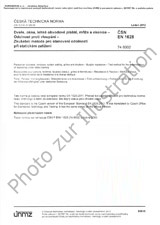Wir benötigen Ihre Einwilligung zur Verwendung der einzelnen Daten, damit Sie unter anderem Informationen zu Ihren Interessen einsehen können. Klicken Sie auf "OK", um Ihre Zustimmung zu erteilen.
ČSN EN 17632-1 (730124)
Building information modelling (BIM) - Semantic modelling and linking (SML) - Part 1: Generic modelling patterns
Name übersetzen
NORM herausgegeben am 1.5.2023
Informationen über die Norm:
Bezeichnung normen: ČSN EN 17632-1
Zeichen: 730124
Katalog-Nummer: 516693
Ausgabedatum normen: 1.5.2023
SKU: NS-1141987
Zahl der Seiten: 100
Gewicht ca.: 331 g (0.73 Pfund)
Land: Tschechische technische Norm
Kategorie: Technische Normen ČSN
Kategorie - ähnliche Normen:
Die Annotation des Normtextes ČSN EN 17632-1 (730124):
This document addresses syntactic and semantic interoperability for information describing assets going through their life cycle in the built environment. It assumes the underlying technical interoperability provided already by the Internet/World Wide Web (WWW) technology-stack. The syntactic aspects relate to the Linked Data (LD)/Semantic Web (SW) formats and the SPARQL direct access method provided. The semantic aspects relate to the LD/SW-based information models in the form of thesauri and ontologies giving meaning to the information.
This document specifies:
- a conceptual "L1: Information language" with four RDF-based language bindings being SKOS, RDFS, OWL and SHACL, including:
- - a choice of ´linked data´/RDF-based formats (to be used for all modelling and language levels); and
- a generic Top Level Information Model of a total "M1: Information model", here "an upper ontology", including:
- - a set of generic information modelling patterns for identification, annotation, enumeration datatypes, complex quality/quantity modelling, decomposition and grouping.
This modelling approach for information models and information sets is relevant within the built environment from multiple perspectives such as:
- - Building information modelling (BIM);
- - Geographical information systems (GIS);
- - Systems engineering (SE);
- - Monitoring & control (M&C); and
- - Electronic document management (EDM).
Annex E discusses in an informative way how the information models and sets relevant for these different worlds can be linked together using LD/SW technology.
This document does not specify a full meta-´information model´, sometimes referred to as a ´Knowledge Model (KM)´. EN ISO 12006-3 provides such an often used model for the built environment. In Annex D, Subclause D.3 it is shown how this existing model can be made compliant to this document. The only direct support for this meta level comes in the form of the possibility to define ´types´ (enumeration types or concept types) and ´objectifications´ as metaconcepts.
This document does not specify a meta-´information language´ since this is already provided by the concrete RDF-based language bindings (being RDFS).
The scope of this document in general excludes the following:
- - Business process modelling;
- - Software implementation aspects;
- - Information packaging and transportation/transaction aspects already handled by ISO TC59/SC13 Information container for linked document delivery (ICDD) ([13]) respectively various information delivery manual (IDM) / information exchange requirements (EIR)-related initiatives; and
- - Domain-specific (here: ´built environment´-specific) content modelling in the form of concepts, attributes and relations at end-user level (the actual ontologies themselves) beyond a generic top level information model (´upper ontology´) and modelling and linking patterns



 Cookies
Cookies
